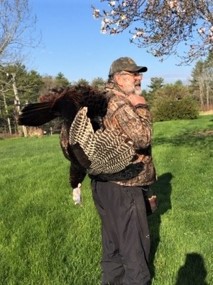Turkey Woods Tips

BY Stu Bristol
“Turkey hunters are merely play actors; the “Turkey Woods” their stage.” I penned that slogan for my call making business back in 1983. That’s when I began making turkey calls for friends and relatives. Each time I head out in search of a longbeard I remind myself of that truism.
Obviously as a 200-pound hunter we can’t dress like a hen turkey to sneak up on a gobbler, so it’s critical that we not only sound like a hen turkey but imitate the sounds of nearly everything in the forest.
If you’ve hunted wild turkeys for a few years, stop and list the different vocalizations you used to lure that trophy into shotgun or bow range.
Eight Note Call
Before daylight we use the eight-note call of the Barred owl to get a gobbler to sound off, giving up its location. Wild turkeys use over 300 different vocalizations in their lifetime but most hunters only try to imitate half a dozen.
The “cluck, purr, kee-kee,fly-down cackle, tree yelps, plain yelps, excited mating yelps” are just a few of the commonly used vocalizations. How successful the hunter is at reproducing these turkey “words” plays a major role in either success or failure.
Knowing when to use each of these vocalizations, at which inflection, cadence and volume come next in the hunters arsenal of calls. Selection of calling device many times will control the hunters options.
The more successful turkey chasers will go afield armed with a vest loaded with; a box call, pot call, usually slate surface, mouth diaphragm and possibly a couple of variations of the basic devices.
The Box Call
The box call is the most foolproof. The hunter merely needs to draw the top paddle across the lips of the call to produce the “yelp.” With the pot and striker call, the calling surface must be cleaned of oxidation then draw the tip of the striker across the surface in a small circular motion to produce yelps. Strike a match action creates a plain cluck. With either call the less dominant hand holds the call and the dominant hand moves the lid or striker.
The caller, from novice to expert needs to constantly practice different strokes and volumes and listen to audio files of real turkeys or calling competitions. In the beginning, I used a tape recorder to listen to real turkeys and match my attempts.
Now, entering the “turkey woods” the hunter needs to clear his or her mind. No family or work problems, no daydreaming about fine cars, shotguns and food.
Sit quietly, close your eyes and try to pick out the dozens of forest sounds. Running water, chipmunks, squirrels, crows and songbirds. Next keeping your head still and moving only your eyes, scan the surroundings for movement of any sort. I look for ground squirrels and birds and many times a turkey pops in sight as if magic.
You need to blend in with your surroundings. My good friend and wildlife artist, Randy Julius would meditate, many times with his eyes closed and pick up subtle rustling of leaves or sot clucks and purrs, each one a possible sign of an approaching turkey or flock.
The “turkey woods” is a very special place to be, regardless if you locate a turkey. In the fall the “turkey woods” becomes the deer woods with the same instruction for the hunter.
Woodsmanship
“Woodsmanship” is a very import part of hunting of all stripes. Understanding your surroundings, “situational awareness,” when it’s alright to move quickly, stealthfully or movement of just the head are all important aspects of being in the “turkey woods.”
Finally, there are no easy ways to kill a turkey; at least not in my playbook. In deer or turkey hunting there are times when even inexperienced get “lucky” and happen on to a deer or turkey ten minutes into the outing and score a kill.
I hope that never happens very often. When I sat down with the lawyer for the Maine Legislature in 1985 I insisted that the wild turkey be designated as a “big game” species with all the rules regulations and penalties. Those of us who attain the designation as “turkeyholics” understand fully why we each feel turkeys are worth that high bar and intimately appreciate the “turkey woods.”
For more articles about hunting, fishing and the great outdoors, be sure to subscribe to the Northwoods Sporting Journal.
For free access to the digital version of the Northwoods Sporting Journal, click here.

 My name is Cody Fish. I enjoy reading the Northwoods Sporting Journal while out on my fishing trips aboard the two 80-90 foot offshore scallop boats I work on. Our trips are typically a week to two weeks long. As we steam out to the fishing grounds, or even home, I frequently find myself reading the whole journal cover to cover. Wonderful advice, tips, and stories to help me remember just how beautiful the state I call home is. I reside in the town of Union, Maine and am an avid deer Hunter and trout fisherman. I am attaching a picture of me holding the journal as I steam the boat towards Cape Cod.
- Cody Fish"
My name is Cody Fish. I enjoy reading the Northwoods Sporting Journal while out on my fishing trips aboard the two 80-90 foot offshore scallop boats I work on. Our trips are typically a week to two weeks long. As we steam out to the fishing grounds, or even home, I frequently find myself reading the whole journal cover to cover. Wonderful advice, tips, and stories to help me remember just how beautiful the state I call home is. I reside in the town of Union, Maine and am an avid deer Hunter and trout fisherman. I am attaching a picture of me holding the journal as I steam the boat towards Cape Cod.
- Cody Fish"